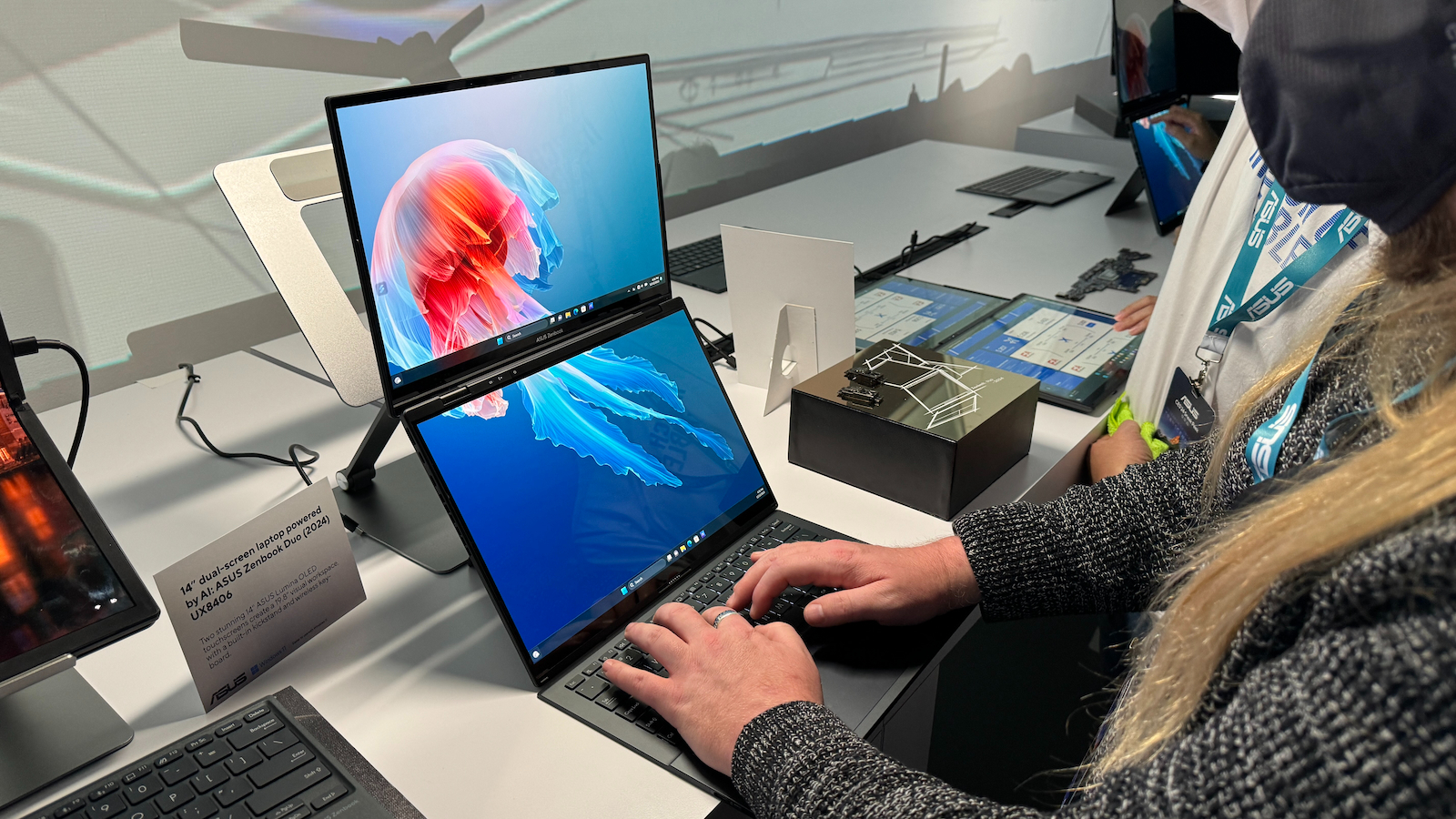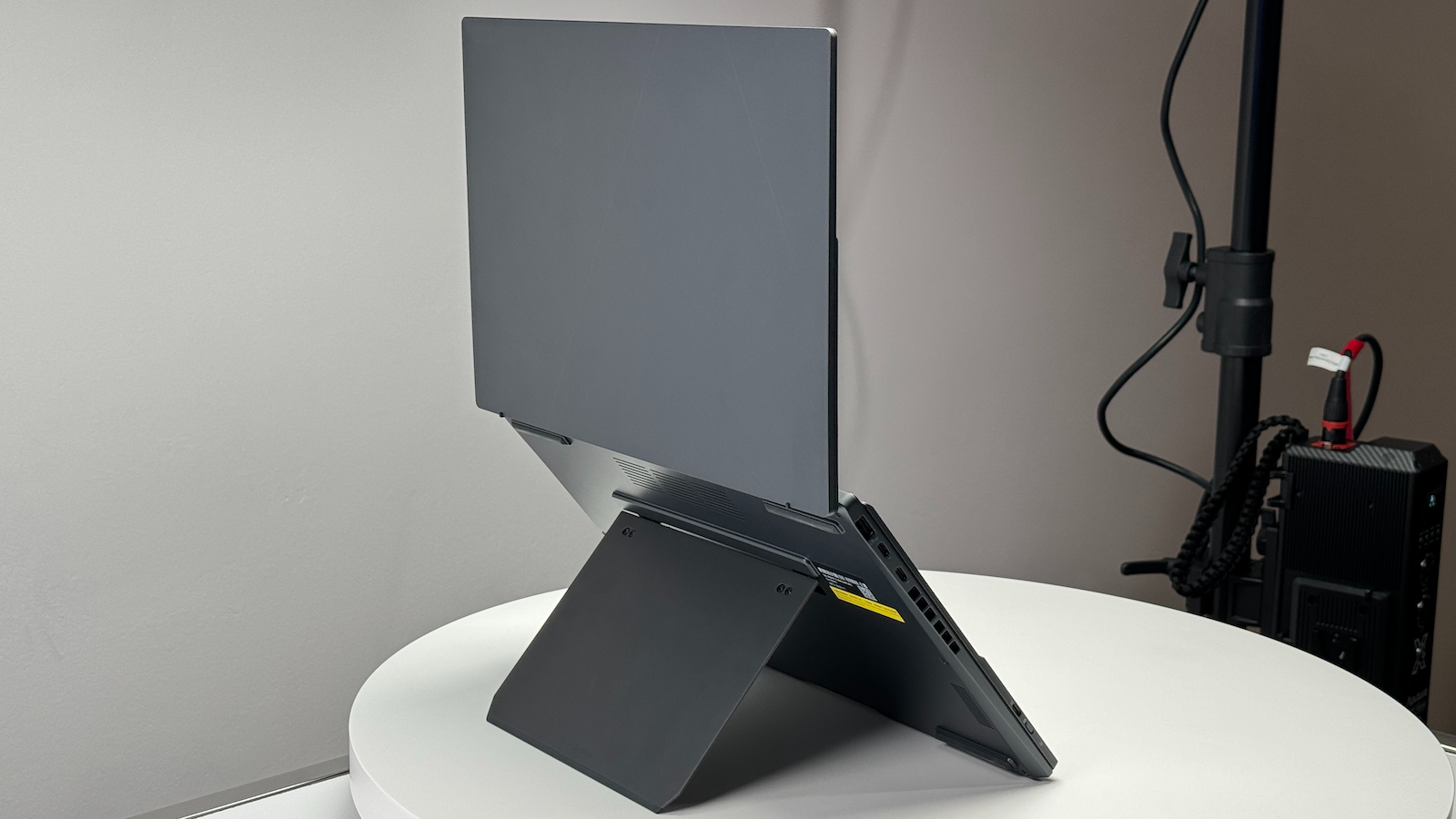Asus Zenbook Duo is a dual-screen foldable with two 14-inch OLED screens and Intel Core Ultra
Asus also has traditional laptop designs and new TUF gaming laptops.

While Asus already has a foldable laptop with a single screen that folds over, it's now jumping further into the foldable market with two feet — and two screens. The Asus Zenbook Duo, which the company is announcing at CES 2024, has a pair of 14-inch OLED displays controlled by a Bluetooth keyboard.
| Header Cell - Column 0 | Asus Zenbook Duo (UX8406) |
|---|---|
| Processor | Up to Intel Core Ultra 9 185H |
| Graphics | Intel Arc (integrated) |
| Memory | Up to 32GB LPDDR5x-7467 |
| Storage | Up to 1TB PCIe Gen 4 SSD |
| Webcam | 1080p, IR |
| Networking | Wi-Fi 6E, Bluetooth 5.3 |
| Battery | 75 WHr |
| Weight (with keyboard) | 3.64 pounds |
| Weight (without keyboard) | 2.9 pounds |
| Release Date | Q1 2024 |
The Zenbook Duo's two 14-inch screens are OLED, 120 Hz panels that add up to a 19.8-inch diagonal when used in dual display mode. While the most similar machine, Lenovo's Yoga Book 9i, uses a detachable kickstand, Asus' is built into the machine. Asus hasn't done this in the most graceful fashion (it feels bolted on), but it means you don't have to worry about losing it.


The Zenbook Duo's two 14-inch screens are OLED, 120 Hz panels that add up to a 19.8-inch diagonal when used in dual display mode. While the most similar machine, Lenovo's Yoga Book 9i, uses a detachable kickstand, Asus' is built into the machine. Asus hasn't done this in the most graceful fashion (it feels bolted on), but it means you don't have to worry about losing it.
Asus is pushing four different use cases here: a dual screen mode, with one display above the other; a desktop mode with the two screens side-by-side; a laptop mode, with the Bluetooth keyboard attached directly to the machine using pogo pins; and a sharing mode, where the screens lay flat on a table displaying identical information. In a brief hands-on, I found it difficult to stand the two screens up vertically (it leaned to one side), but hopefully I just need more time and practice with it. It felt pretty solid in dual-screen mode, with the two screens stacked.


The magnetic keyboard comes in the box. It felt a bit cheap to me in my hands, though considering it would likely be attached to the computer or flat on the desk, it will take more time to decide how much that matters. The pogo pins on the keyboard charge the keyboard, which is nice as it doesn't inherently require a USB cable.
Asus didn't skimp on ports: the Zenbook Duo features two Thunderbolt 4 ports over USB Type-C, a USB 3.2 Gen 1 Type-A port (which I was surprised to see), HDMI 2.1 out and a 3.5 mm audio jack.


The Zenbook Duo is powered by up to an Intel Core Ultra 9 185H, up to 32GB of RAM, and up to 1TB of storage. It is set to launch in Q1 2024, but Asus told Tom's Hardware pricing will come closer to its release date.
Asus Zenbook 14 (UM3406)
Asus is also using CES as the launch point for a new AMD-powered laptop in a more traditional laptop design, the Zenbook 14 (UM3406)
Get Tom's Hardware's best news and in-depth reviews, straight to your inbox.
This notebook will use an AMD Ryzen 7 8840HS, 16GB of LPDDR5X-7500 RAM, and up to 1 TB of PCIe Gen 4 SSD storage. The display is a 14-inch, 1920 x 1200 "Lumina" OLED screen with 2880 x 1800 resolution and 120 Hz refresh rate. The whole thing looks similar to the Intel-based option that launched in December. The UM3406 has a 75 WHr battery and is just 14.9 mm (0.59 inches) thick. Asus claims the chassis is "around 10% more compact" than the prior model. Expect to see this one later in Q1.
Asus TUF Gaming F16, A16 and A15
Lastly, Asus' budget TUF gaming notebooks are also getting a refresh with new Intel and AMD options.
The F16 is an Intel-based option powered by a 13th Gen Intel Core i7-13650HX, so it is not the latest and greatest. That's paired with an RTX 4060 Laptop GPU, up to 32GB of RAM and up to 2TB of storage.
The A16 is using last-gen AMD Ryzen, with a Ryzen 9 7845HX and an Nvidia GeForce RTX 4070. The A15 uses newer Ryzen 8000-series chips, but Asus hasn't specifically said which ones will be available.
Both 16-inch laptops are getting redesigned chassis to fit the 16-inch, 16:10 screens (the A15 is sticking with 16:9), and they come in two different shades of gray. They also both have 90 WHr batteries and can be charged over USB Type-C.
Asus didn't immediately provide the TUF lineup's exact pricing or release dates.

Andrew E. Freedman is a senior editor at Tom's Hardware focusing on laptops, desktops and gaming. He also keeps up with the latest news. A lover of all things gaming and tech, his previous work has shown up in Tom's Guide, Laptop Mag, Kotaku, PCMag and Complex, among others. Follow him on Threads @FreedmanAE and BlueSky @andrewfreedman.net. You can send him tips on Signal: andrewfreedman.01
-
Notton I like the stacked wide mode. It's like an LG dualup, except portable.Reply
But that side-by-side "book" mode doesn't look well thought out. Who looks at a screen like that? Usually you want it at an angle. -
pixelpusher220 Reply
Not sure either format works. Having to use a seemingly rickety stand to support that tall is just waiting for tip over on being bumped.Notton said:I like the stacked wide mode. It's like an LG dualup, except portable.
But that side-by-side "book" mode doesn't look well thought out. Who looks at a screen like that? Usually you want it at an angle.
Needs to be ultra thin monitors that extend/attach to the sides of the main display to be really useful.
Think I've seen a couple concepts of that, and it does make it *very* thick, but that's the only really viable use scenario.


